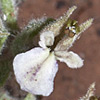Teucrium montbretii is an herbaceous perennial , wooly to velvety, and canescent. It branches at the base into many stems, which are square in cross-section, easily broken, and 5-30 cm in length. The leaves are opposite, petiolate, ovate, crenate, and 0.5-1.5 cm long. Leaves along the stalk of the inflorescence are lanceolate, have pointed tips (acute), and are slightly shorter than the sepals.
The inflorescence is a dense spike with two, opposite flowers per node. The calyx is hairy, campanulate, ending with triangular teeth. The calyx is about half the length of the corolla tube. The three upper teeth of the calyx are dark and ovate. The two lower teeth are lanceolate. The corolla has a single purple lip (palate). The flower has four stamens which protrude slightly from the floral tube.
Teucrium montbretii is a rare plant which grows on steep cliff faces or in rock fissures in wadis of the Samarian and Judean Mountains.
There are approximately 300 species in the genus Teucrium, with nearly worldwide distribution. The characteristic feature of the genus is the appearance of a single lip (palate) of the corolla; the upper lip (hood) is reduced so that it is very short and is mostly hidden by the calyx. The lower lip of the corolla is divided into five lobes. The central one is the largest and concave, and the others are elongated. Most of the species are principally pollinated by bees. The Hebrew name is derived from the Arabic word meaning ‘curly’, probably due to the appearance of the leaves in a number of the species in the genus. The Latin name refers to King Teucer of Troy, who allegedly was the first to recognize the medicinal properties of the plant.
Written by Liora Keret




